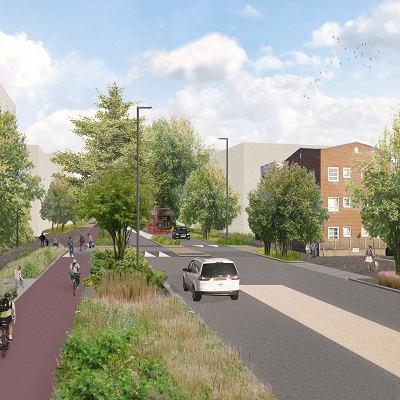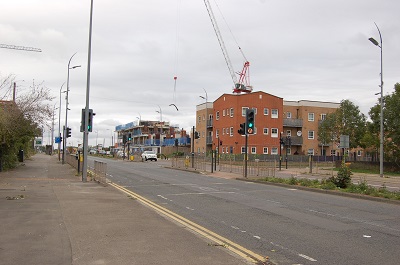The Beam Parkway linear park scheme is a Council project that aims to transform a 2km length of New Road that runs through the Rainham and Beam Park Housing Zone.
The Beam Parkway scheme was to be funded through partnerships with Transport for London, The Greater London Authority and local developer contributions.
Due to financial difficulties resulting from the pandemic, TfL have been unable to confirm their funding contribution.
The Council are therefore investigating other funding options with a view to progressing the project.
The proposed scheme would include new pedestrian footpaths and cycle lanes to improve transport connections between the North and the South of the borough and the link to Rainham Village.
The scheme would provide an attractive frontage for new developments and bring together the natural environment of the Beam and Ingrebourne rivers with new green spaces, increased accessibility for local residents and improved air quality.
Map of location
Existing and proposed views
Existing view looking west along New Road at Spencer Road junction.
Proposed view with reduced carriageway, new two way cycle track, improved footways on both sides of the Parkway, new energy efficient street lighting, planted swales and other planting.
Connections would be improved through new raised informal crossings to the Parkway and continuous footways across existing side roads.

Did you know?
New Road was built in 1810.
Tilbury Turnpike Trust started work on New Road to extend Ripple Road to Rainham to shorten the distance troops would have to travel to the fort at Tilbury during the Napoleonic War.
New Road in Hornchurch is situated between the historic village of Rainham to the east, with links to Rainham Marsh and the River Thames and Beam Parklands, Beam Valley Country Park and the Chase Local Nature Reserve to the west.
On the riverbanks you may discover burrows along rivers, streams and ditches.
The watercourses provide ideal habitat for the water vole to dig their burrows and feed on grasses growing on the banks.
The water vole was once a familiar sight on waterways and ponds throughout England.
Their decline has been most rapid in the last 30 years and a recent survey showed that the species has been lost from almost 90 percent of the sites where they lived earlier this century.
The reasons for this decline are complex but involve a combination of loss and fragmentation of bank side vegetation, altered methods of riverbank management and perhaps critically, the introduction and spread of mink, an effective predator of water voles.
Water voles are now fully protected under Schedule 5 of the Wildlife and Countryside Act 1981.
The story so far
- March 2017 - Public consultation plans to redevelop a number of sites along the A1306 (New Road)
- June 2018 - Public consultation Beam Parkway scheme
- June 2020 - Public consultation Rainham and Beam Park development sites
- Press releases - 2021 - Withdraw CPO and 2022 - Beam Park Station


